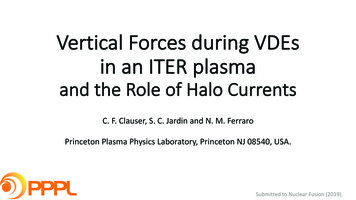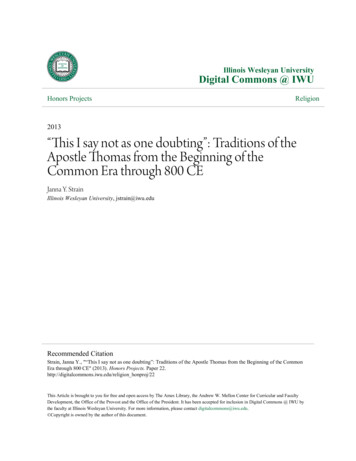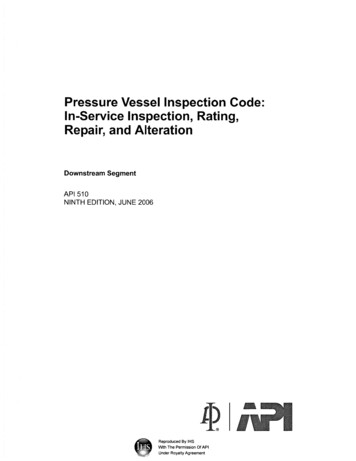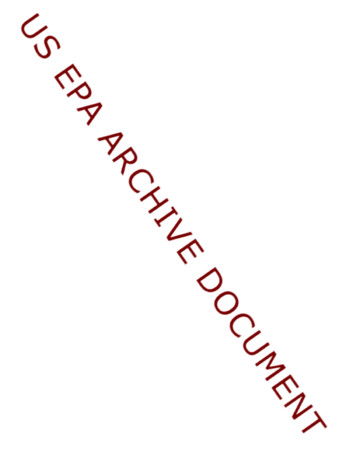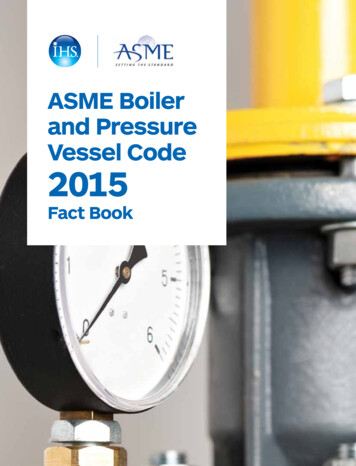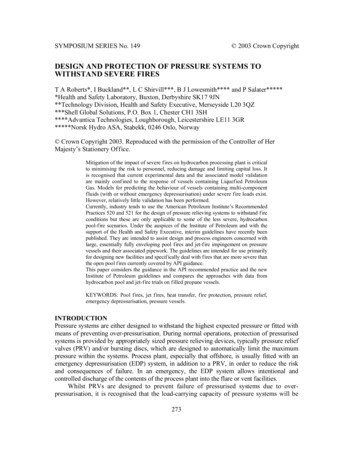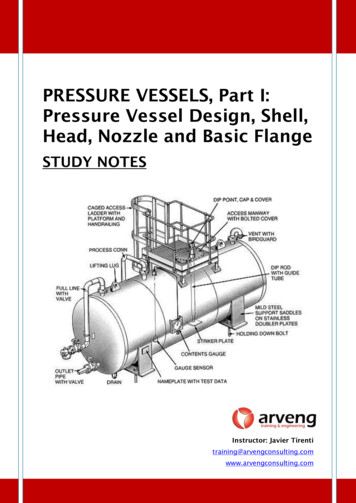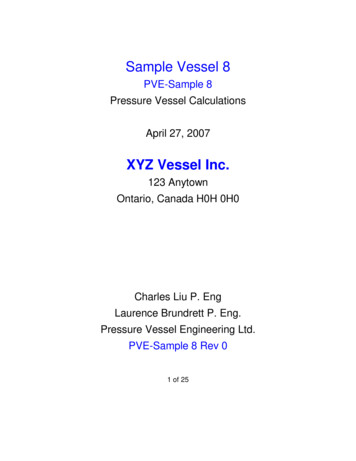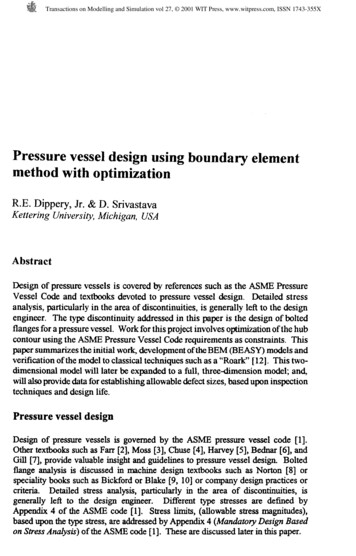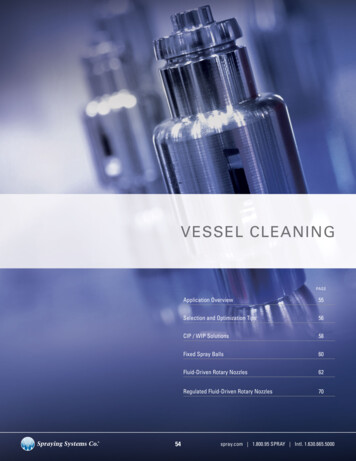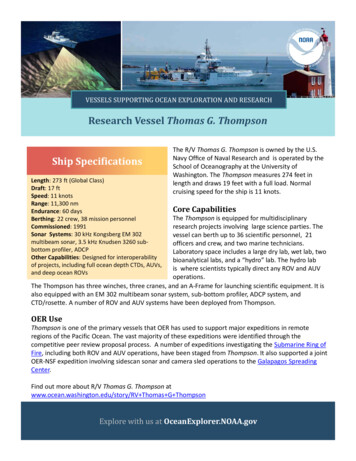
Transcription
VESSELS SUPPORTING OCEAN EXPLORATION AND RESEARCHResearch Vessel Thomas G. ThompsonShip SpecificationsLength: 273 ft (Global Class)Draft: 17 ftSpeed: 11 knotsRange: 11,300 nmEndurance: 60 daysBerthing: 22 crew, 38 mission personnelCommissioned: 1991Sonar Systems: 30 kHz Kongsberg EM 302multibeam sonar, 3.5 kHz Knudsen 3260 sub‐bottom profiler, ADCPOther Capabilities: Designed for interoperabilityof projects, including full ocean depth CTDs, AUVs,and deep ocean ROVsThe R/V Thomas G. Thompson is owned by the U.S.Navy Office of Naval Research and is operated by theSchool of Oceanography at the University ofWashington. The Thompson measures 274 feet inlength and draws 19 feet with a full load. Normalcruising speed for the ship is 11 knots.Core CapabilitiesThe Thompson is equipped for multidisciplinaryresearch projects involving large science parties. Thevessel can berth up to 36 scientific personnel, 21officers and crew, and two marine technicians.Laboratory space includes a large dry lab, wet lab, twobioanalytical labs, and a “hydro” lab. The hydro labis where scientists typically direct any ROV and AUVoperations.The Thompson has three winches, three cranes, and an A‐Frame for launching scientific equipment. It isalso equipped with an EM 302 multibeam sonar system, sub‐bottom profiler, ADCP system, andCTD/rosette. A number of ROV and AUV systems have been deployed from Thompson.OER UseThompson is one of the primary vessels that OER has used to support major expeditions in remoteregions of the Pacific Ocean. The vast majority of these expeditions were identified through thecompetitive peer review proposal process. A number of expeditions investigating the Submarine Ring ofFire, including both ROV and AUV operations, have been staged from Thompson. It also supported a jointOER‐NSF expedition involving sidescan sonar and camera sled operations to the Galapagos SpreadingCenter.Find out more about R/V Thomas G. Thompson atwww.ocean.washington.edu/story/RV Thomas G ThompsonExplore with us at OceanExplorer.NOAA.gov
VESSELS SUPPORTING OCEAN EXPLORATION AND RESEARCHResearch Vessel Atlantis IIShip SpecificationsLength: 274 ft (Global Class)Draft: 19 ftSpeed: 10 knotsRange: 17,280 nmEndurance: 60 daysBerthing: 36 crew, 24 mission personnelCommissioned: 1997Sonar Systems: 12 kHz Kongsberg EM122, RDIOcean Surveyor 75 KHz ADCPOther Capabilities: Sole operator of HOV Alvin;can host joint ROV/AUV/HOV operationsThe research vessel (R/V) Atlantis is owned by the U.S.Navy and operated by WHOI for the oceanographiccommunity. It is one of the most sophisticatedresearch vessels afloat, and it is specifically outfittedfor launching and servicing the Alvin human occupiedvehicle (HOV) The ship carries a complement of 36crew members, science technicians, deepsubmergence group members, as well as a scientificparty of 24 men and women for as long as 60 days.The ship operates in all of the world’s oceans.Core CapabilitiesThe Atlantis is equipped with a variety of permanenttools, including a CTD Rosette; an acoustic Dopplercurrent profiler; a Kongberg EM122 multibeamsystem. The ship is specially outfitted to support HOVAlvin. Alvin carries two scientists and a pilot on dives lasting six to ten hours. Its maximum depthis 4,500 m. Alvin’s most recent overhaul was completed in 2013 and included an expanded sphere,additional viewports, and new lighting and camera systems. Alvin’s most recent overhaul wascompleted in 2013 and included an expanded sphere, additional viewports, and new lighting andcamera systems.OER UseOER has conducted missions on the Atlantis in support of the Extended Continental Shelf (ECS) project,partnership projects with the Bureau of Ocean Energy Management, and projects funded through OER’sFederal Funding Opportunities. Examples of OER supported expeditions on the Atlantis include: 2014and 2012 ECS mapping; 2006 Expedition to the Deep Slope; 2004 Gulf of Alaska; 2003 Mountains in theSea; 2003 Windows to the Deep; 2002 Galapagos Rift; 2002 Exploring Alaska’s Seamounts.Find out more about R/V Atlantis II at www.whoi.edu/main/ships/atlantisExplore with us at OceanExplorer.NOAA.gov
VESSELS SUPPORTING OCEAN EXPLORATION AND RESEARCHNOAA Ship Okeanos ExplorerShip SpecificationsLength: 224 ft (Ocean Class)Draft: 17 ftSpeed: 10 knotsRange: 9600 nm, 45 N to 45 SEndurance: 40 daysBerthing: 26 crew, 20 mission personnelCommissioned: August 13, 2008Sonar Systems: Kongsberg EM 302multibeam sonar, Knudsen 3260 sub‐bottom profiler, Kongsberg EK‐60 single‐beam sonarOther Capabilities: Cutting‐edgetelepresence technology and fullyintegrated with ROV Deep DiscovererCore CapabilitiesOkeanos Explorer, “America’s Ship for Ocean Exploration,” ison a global mission to explore the depths of Earth’s lastfrontier. Operated by the National Oceanic and AtmosphericAdministration (NOAA), the Okeanos Explorer is the onlyfederal vessel dedicated to collaborative, systematicexploration of unknown and poorly known areas of our worldocean. Relying on the inputs of a collaborative process withpartners and stakeholders, expeditions are planned andexecuted in priority deep ocean areas to provide a foundationof standards‐based, publicly accessible data that meets thecurrent and future needs of as many stakeholders as possible,and catalyze follow‐on research and management activities.The telepresence‐enabled vessel operates with an open,collaborative participation model that enables interestedscientists, students and marine resource managers toparticipate in real‐time from shore, and allows broaderaudiences to follow the exploration live online.Okeanos utilizes cutting edge deep‐water technologies to explore and characterize unknown or poorlyknown areas, features, and ocean phenomena as deep as 6000 m. Okeanos is equipped with a KongsbergEM 302 multibeam sonar, a Knudsen 3260 sub‐bottom profiler, and a Kongsberg EK‐60 single‐beam sonar.During mapping operations the sonars continuously record seafloor bathymetry, seabed backscatter, andwater column backscatter data, collecting valuable environmental intelligence around the clock includingduring transit operations. Okeanos also uses a CTD rosette carousel that can be outfitted with additionalsensors to characterize the water column. ROV Deep Discoverer (D2), is OER’s dedicated, fully integrated,6,000 m capable dual‐body ROV system. D2 is outfitted with two HD video cameras, a downward‐lookingstill camera, a CTD, and four specially designed adjustable swing arms with LED lights to attain optimallighting . D2 also has a 200 lbs scientific payload for additional sensors. During operations the ship’s VSATsatellite dish allows the ship to stream up to 20 mbps of data and information (including three HD videofeeds) to shore, enabling scientists to join the exploration from anywhere with an internet connection.Find out more about NOAA Ship Okeanos Explorer at oceanexplorer.noaa.gov/okeanosExplore with us at OceanExplorer.NOAA.gov
VESSELS SUPPORTING OCEAN EXPLORATION AND RESEARCHNOAA Ship Nancy FosterShip SpecificationsLength: 187 ft (Regional Class)Draft: 11.2 ftSpeed: 10.5 knotsRange: 3,500 nmEndurance: 15 daysBerthing: 22 crew, 15 mission personnelCommissioned: May 10, 2004Sonar Systems: Kongsberg EM 710, Reson7125 SV2, Teledyne RDI Ocean Surveyor150kHz ADCPOther Capabilities: Designed forinteroperability of projects includingmapping missions, CTD work, AUVs, andsmall ROVsNOAA Ship Nancy Foster is a multi‐purpose vessel operated bythe National Oceanic and Atmospheric Administration. It hasa 15 day endurance and a range of 3,500 nautical miles withan 10.5 knot cruising speed. The ship carries a complement of22 crew members, technicians, and engineers as well as a upto 15 members of a scientific party.Core CapabilitiesOperations include the characterization of habitats and faunain coastal waters, bathymetric surveys, physical and chemicaloceanography studies, maritime heritage surveys, andpollution assessments. The vessel employs state of the artnavigation, propulsion, and mission systems resulting in highquality and efficient data collection through multibeamsonars, split beam sonars, and a vast array of oceanographicand atmospheric sensors. Additional capabilities includewater and sediment sampling, net towing, sub‐bottomprofiling, diving with air and NITROX, AUV and ROV support with dynamic positioning, small boatoperations, and buoy servicing. In 2015, the Foster was outfitted with a new Kongsberg EM 710multibeam system which will allow mapping operations to be conducted to depths up to 2,000 meters.OER UseOER has used Foster to support numerous expeditions related to the competitive peer review processand BOEM‐USGS‐OER partnership in the Western Atlantic and Gulf of Mexico. Given its size andcapabilities, Foster operations are relatively shallow in comparison to Brown and Okeanos Explorer. MostOER‐sponsored Foster expeditions involve smaller ROVs and multibeam mapping in shallow waters.Example s of Foster expeditions include: 2012 Mid‐Atlantic Canyons, 2009 and 2008 joint BOEM‐USGS‐OER Lophelia Expeditions in the Gulf of Mexico; and 2006 South Atlantic Bight. OER also provided basefunding in the early 2000s during the ship’s conversion to increase the ship’s exploration capabilities.Find out more about NOAA Ship Nancy Foster here: www.moc.noaa.gov/nf/Explore with us at OceanExplorer.NOAA.gov
VESSELS SUPPORTING OCEAN EXPLORATION AND RESEARCHExploration Vessel NautilusShip SpecificationsLength: 211 ft (Ocean Class)Draft: 14.75 ftSpeed: 10 knotsRange: 13,000 nm, 45 N to 45 SEndurance: 40 daysBerthing: 17 crew, 31 mission personnelCommissioned: August 13, 2008Sonar Systems: Kongsberg EM 302 multibeamsonar, Knudsen 3260 sub‐bottom profiler, anEdgeTech 4200 MP CHIRP side‐scan sonarOther Capabilities: Integrated telepresencetechnology, a complete production studio andfully integrated with ROVs Hercules and ArgusOcean Exploration Trust’s vessel, E/V Nautilus, is one ofonly two dedicated ships of exploration in the world.The ship is outfitted for a two‐tiered approach toexploration. First the team uses a multibeam sonarsystem to map unknown areas of the seafloor. Once thedata is analyzed and targets are chosen, they useremotely operated vehicles (ROVs) to collect videofootage and a variety of samples.Core CapabilitiesThe Nautilus Exploration Program focuses on threemain areas of marine science: biology, geology, andarcheology. No matter what area a particular cruisefocuses on, the Nautilus is ready for whatever they maycome across in the depths of the sea. Cutting‐edgetelepresence technology enable the ship to broadcasthigh definition video from the seafloor to anyone on shore in near‐real time.Nautilus’s sonar systems can efficiently map the seafloor in waters up to 7,000 meters deep. The EM302multibeam sonar collects bathymetric data, surface sediment characteristics, and water column data,while the Knudsen 3260 collects data on the geological structure beneath the seafloor. The data thesesonars collect help identify areas or features of interest for ROV dives. The dual body 4,000 m ROV system,ROVs Hercules and Argus, is the workhorse of the Nautilus Exploration Program. Hercules is equipped withtwo manipulator arms for collecting samples and recovering artifacts.OER UseThe Nautilus operates similar tools and technology as NOAA Ship Okeanos Explorer. Through their globalreach, robust internship and fellowship programs, and extensive outreach and education efforts, theNautilus Program is a complementary investment in the future of understanding our largely unknownocean, and in the development of emerging ocean leaders, scientists, policymakers and educators.Find out more about Exploration Vessel Nautilus at www.NautilusLive.orgExplore with us at OceanExplorer.NOAA.gov
VESSELS SUPPORTING OCEAN EXPLORATION AND RESEARCHNOAA Ship Ronald H. BrownShip SpecificationsLength: 274 ft (Global Class)Draft: 17 ftSpeed: 11 knotsRange: 11,300 nmEndurance: 60 daysBerthing: 29 crew, 31 mission personnelCommissioned: July 19, 1997Sonar Systems: 12 kHz Kongsberg EM122, RDIOcean Surveyor 75 KHz ADCPOther Capabilities: Designed forinteroperability of projects including full oceandepth CTDs, AUVs, and deep ocean ROVsNOAA Ship Ronald H. Brown is a largest oceanographicresearch vessel in the NOAA fleet. Operated byNOAA’s Office of Marine and Aviation Operations, theBrown is staffed with 29 crew and can carry up to 31scientists. It has a 60 day endurance and a range of11,300 nautical miles with an 11 knot cruising speed.Since being commissioned in July 1997, theBrown has worked in every ocean basin.Core CapabilitiesNumerous on‐board instruments are used to collectand assess scientific data from above and below theocean surface. The Brown is equipped with a variety ofpermanent tools, including a CTD/Rosette; an acousticDoppler current profiler; a series of wet and drylaboratories; and a full ocean depth Kongsberg EM122 multibeam system for seabed mapping. TheBrown also has a sophisticated suite of meteorological sensors that continuously collect data while theship is underway. The Brown also has a series of cranes, winches, and a rear mounted A‐frame thataccommodate heavy scientific gear such as remotely operated vehicles, benthic landers, moorings, andbuoys.OER UseOER has conducted expeditions on the Brown in support of Extended Continental Shelf mapping, thejoint BOEM‐USGS‐OER partnership, and the competitive peer review proposal process. Examples ofOER expeditions staged from the Brown include: 2013 Mid‐Atlantic Canyons expedition, 2010 post‐Deepwater Horizon investigations of Gulf of Mexico deepwater corals; 2007 Gulf of MexicoChemosynthetic Communities; 2004 Return to the Titanic; 2004 Mountains in the Sea; 2003 PuertoRico Trench; 2003 U‐166; 2003 Gulf of Mexico Deep Sea Medicines.Find out more about NOAA Ship Ronald H. Brown at www.moc.noaa.gov/rb/index.htmlExplore with us at OceanExplorer.NOAA.gov
VESSELS SUPPORTING OCEAN EXPLORATION AND RESEARCH NOAA Ship Nancy Foster Ship Specifications Length: 187 ft (Regional Class) Draft: 11.2 ft Speed: 10.5 knots Range: 3,500 nm Endurance: 15 days Berthing: 22 crew, 15 mission personnel Commissioned: May 10, 2004 Sonar Systems: Kongsberg EM 710, Reson 7125 SV2, Teledyne RDI Ocean Surveyor
